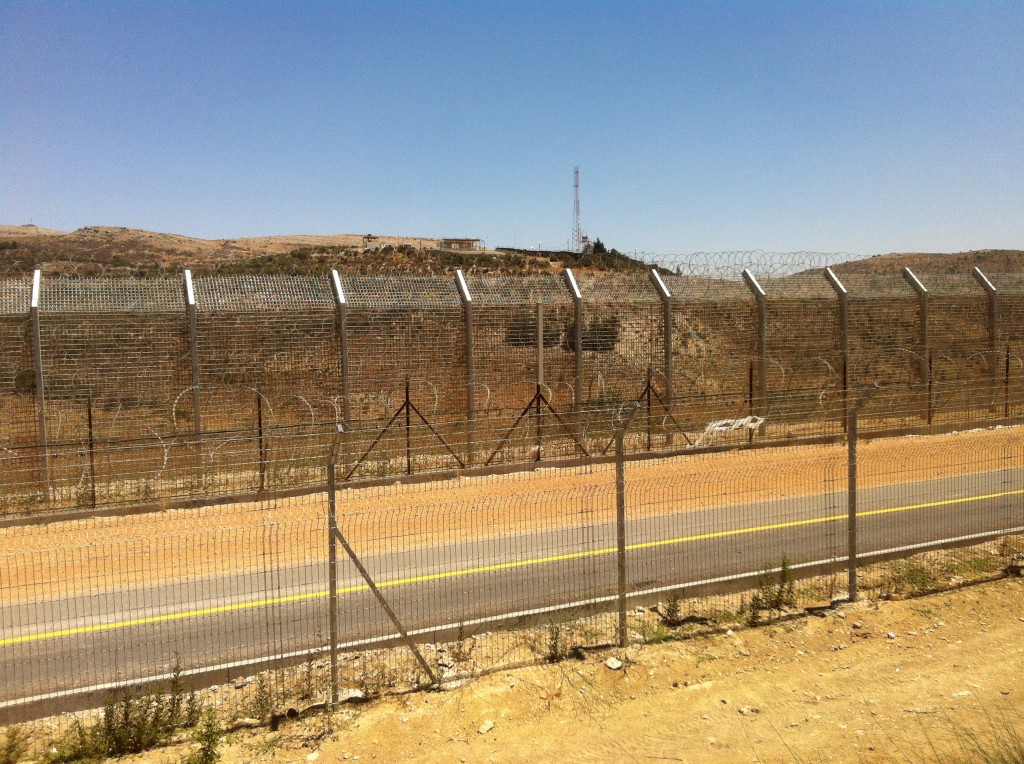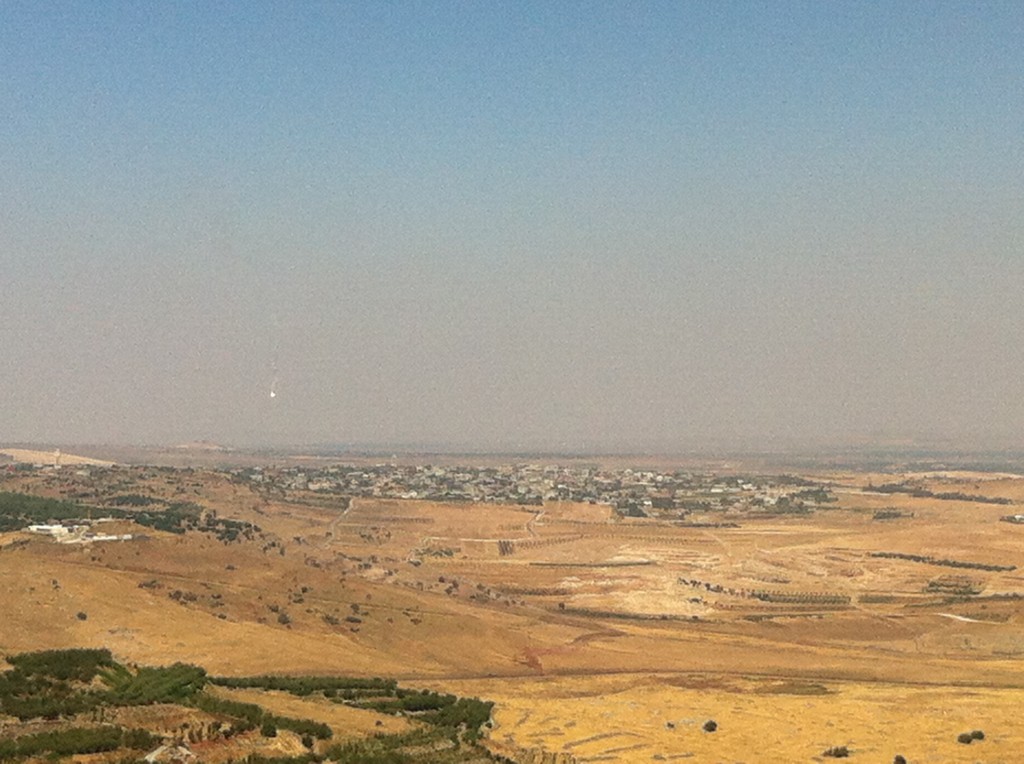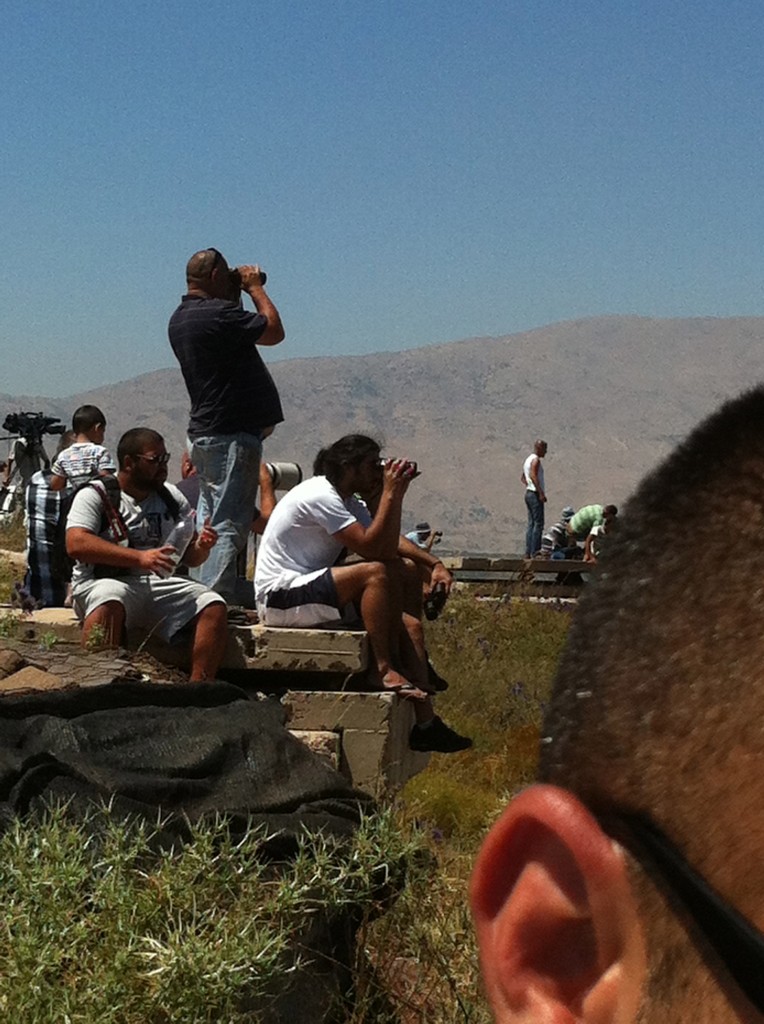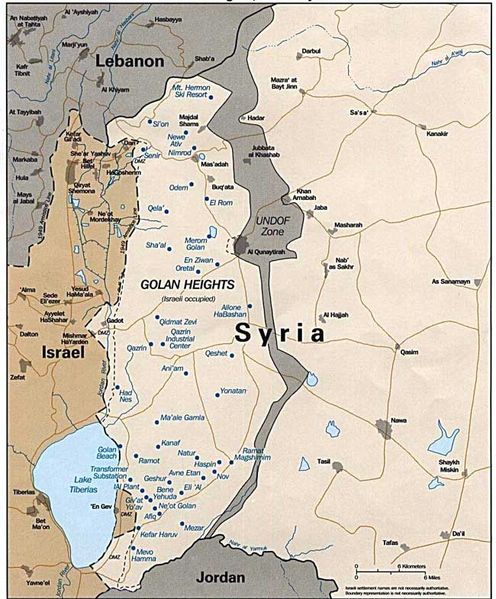
Soldat israélien qui regarde vers la Syrie depuis les hauteurs de Bu’qata, 23 juillet 2012.
An Israeli soldier looking at Syria from the Golan Heights
www.merblanche.com all rights reserved
En Israël, on regarde de très près ce qu’il se passe en Syrie. D’autant que l’Etat hébreu a une frontière commune avec le régime de Bachar Al Assad. Il s’agit du Plateau du Golan, situé dans le nord d’Israël, à l’est du Lac de Tibériade. Un territoire syrien occupé (1967) et annexé (1981) par Israël. Une annexion que ne reconnaît pas la communauté internationale.
L’accord de cessez-le-feu conclu en 1974 prévu une zone démilitarisée contrôlée par l’ONU entre les 2 pays. Un couloir de 3 à 6 kilomètres où patrouille un millier d’hommes de la force des Nations Unies chargée d’observer le désengagement (FNUOD).
In Israel, people look closely at what is happening in Syria. Israel shares a border with Assad’s regime : the Golan Heights in the Northern Israel, east of Tiberias lake. It’s a Syrian territory occupied (1967) and annexed (1981) by Israel.
Both countries signed an armistice in 1974 and a UN observer force (FNUOD) has been in place on the ceasefire line since 1974. Currently there are more than 1,000 UN peacekeepers there.
Le Plateau du Golan compte aujourd’hui environ 40 000 habitants : 20 000 Israéliens installés dans une trentaine de colonies et 20 000 Syriens qui font pour la plupart partie de la communauté Druze (et qui disposent aujourd’hui de la citoyenneté israélienne). De là, Damas n’est qu’à seulement 60 kilomètres. Et dans le village druze de Majdal Shams, la frontière est à moins d’un kilomètre du centre ville.
40,000 poeple live currently in the Golan Heights : 20,000 Israelis in approx. 30 settlements and 20,000 Syrians, most of them members of the Druze sect (and who has now an Israeli citizenship). From here, Damas is only 60 km away. And from the city center of the Druze village of Majdal Shams, the border is only 1km away from the city center.

La frontière Israélo-syrienne du côté du village druze de Majdal Shams.
The Israeli-Syrian border from the Druze village of Majdal Shams.
www.merblanche.com all rights reserved
Pendant 4 jours (de jeudi 19 au dimanche 22 juillet), les habitants du Golan ont assisté impuissants au bombardement du village syrien de Jubata al Khabash situé à moins de 4 kilomètres.
For 4 days (19-22 July, 2012), Golan Heights inhabitants witnessed, helpless, the bombing of the Syrian village of Jubata al Khabash located at less than 4 km away.
Le bruit des bombardements depuis la ville de Majdal Shams. A écouter avec des écouteurs. The sound of the bombings captured in Majdal Shams. To be listened with headphones.

Le village syrien de Jubata al Khashab. En haut à gauche, une fusée éclairante lancée entre deux bombardements le 22 juillet 2012.
The Syrian village of Jubata al Khabash. On the up left corner, a flare rocket launched between two bombings.
www.merblanche.com all rights reserved
Dimanche, sur les hauteur, des dizaines de personnes sont venues épier ce qu’il se passe aux jumelles. On voit les colonnes de fumée s’échapper des bâtiments bombardés, les explosions déchirent l’air toutes les 3 à 5 minutes, aucun mouvement n’est visible, le village a l’air fantôme. 10 000 personnes y habitent pourtant selon les Druzes de Golan et des combattants de l’Armée syrienne libre s’y seraient réfugiés.
On Sunday, up in the hills, dozens of people came to see with binoculars what was happening on the other side. We can see smoke, we can hear explosions every 3 or 5 minutes, nothing is moving in the village, it’s like a dead place. Yet, 10,000 people are said to be living there, where rebels of the Free Syrian Army might have found a shelter.

Des habitants du Plateau du Golan entrain de regarder ce qu’il se passe de l’autre côté de la frontière.
Golan Heights inhabitants watching the bombings happening on the Syrian side.
www.merblanche.com all rights reserved
Sur notre point d’observation, il y a les cris indignés de certaines personnes, et les slogans pro-Assad d’autres.
La scène est irréelle… tout le monde semble sonné.
Ces bombardements ne sont pas anodins. Ils se passent à moins d’un kilomètre de la frontière avec Israël (un pays qui est toujours officiellement en guerre avec la Syrie) et dans la zone démilitarisée contrôlée par les Nations Unies.
Where we are, we can hear people next to us screaming at every bombing and others shouting pro-Assad slogans.
These bombings are taking place at less than 1 km away with the Israeli border (Israel is still officially in a state of war with Syria) and within the UN controlled zone.
Pourtant, ni l’armée israélienne ni la mission d’observation de l’ONU n’ont réagit. Tout ce que l’on sait c’est que le gouvernement israélien a renforcé sa présence militaire à la frontière et qu’il a officiellement porté plainte devant l’ONU.
For now, neither the UN observation mission nor the Israeli army responded. The only thing we know is that the Israeli government sent more troops to the border and officially filled a complaint to the UN.
Le conflit en Syrie et ces combats tout près d’Israël mettent en lumière la situation atypique des Druzes du Plateau du Golan. Ils parlent hébreu et arabe, ils se sentent syrien pour la plupart, bénéficient de la citoyenneté israélienne mais n’ont pas de passeport. La plupart rêvent du jour où le Plateau du Golan sera rendu à la Syrie. Certains regardent avec espoir vers l’Armée syrienne libre. Une nouvelle Syrie signifierait, ils en sont sûrs, un retour de leur village sous l’escarcelle de Damas.
This conflict also cast a light on the Druze community living in the Golan Height. Those people speak hebrew and arabic, most of them feel Syrian, they have an Israeli citizenship but they don’t have a passport. Most of them dream that one day the Golan Height will be returned to Syria. Some of them hope that if the Free Syrian Army win, they will be part of Syria again.

Le village druze de Majdal Shams à 1km de la frontière syrienne. Au dessus de cette statue du centre-ville, le drapeau syrien
The Druze village of Majdal Shams, 1km away from the Syrian border. The Syrian flag over the statute.
www.merblanche.com all rights reserved


i enjoy your blog posts, thanks for posting this informative article.
Howdy. I came across the weblog the in google. This is an excellent post. I’ll be sure to book mark that along with resume get more information of your tips. We appreciate you the submit. it’s going to undoubtedly go back.
May i just say such a comfort to find someone that really is aware just what they are really talking about on the internet. You certainly understand how to deliver a worry for you to gentle making that crucial. The best way to have to read this as well as see why facet of the history. I cannot consider youre not widely used since you absolutely hold the present.